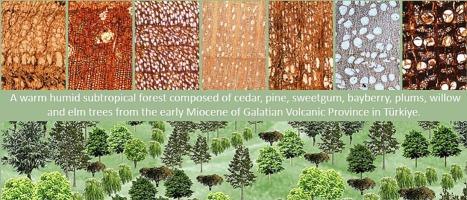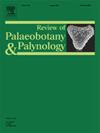土耳其加拉太火山省早中新世新化石林及其古气候学评价
IF 1.7
3区 地球科学
Q2 PALEONTOLOGY
引用次数: 0
摘要
加拉太火山省拥有丰富多样的化石木材,确定新的化石木材地点、物种和森林组成为该地区中新世早期的森林和气候提供了更多信息。在此背景下,本研究旨在通过对Kıbrıscık-Sarıkaya化石区化石树的识别,加深对早中新世GVP森林结构、气候和树木组成的空间分布的认识。在Bolu-Kıbrıscık-Sarıkaya村附近的地点共收集了20个木材化石样本。显微分析显示存在雪松anatolica Akkemik, Pinuxylon diverradiatum (s本文章由计算机程序翻译,如有差异,请以英文原文为准。

A new early Miocene fossil forest of the Galatian Volcanic Province (Turkey) and its evaluation in respect of palaeoclimatology
The Galatian Volcanic Province has a rich diversity of fossil wood, and identifying new fossil wood sites, species and forest compositions provides more information about the region's forests and climate in the Early Miocene. Against this backdrop, this study aims to enhance our understanding of the spatial distribution of forest structures, climates and tree compositions in the Early Miocene GVP by identifying fossil trees in the Kıbrıscık-Sarıkaya fossil area. A total of 20 fossil wood samples were collected from the site near the village of Bolu-Kıbrıscık-Sarıkaya. Microscopic analysis revealed the presence of Cedrus anatolica Akkemik, Pinuxylon diversiradiatum (Süss & Velitzelos) Mantzouka & Akkemik, Prunoidoxylon prunoides Akkemik, Salicoxylon galatianum Akkemik, Myricoxylon unalakkemikii H.Çelik, Ulmoxylon kasapligilii Akkemik and Liquidambaroxylon efeae Akkemik. The species composition indicates that the closest living relatives' climatic characteristics suggest an environment where the range of the lowest temperature in the coldest month and the highest temperature in the hottest month varies between − 0.3 and 29.3 °C. In terms of precipitation, the estimated range during the time in which the fossil trees lived was 578–1577 mm. The mean annual precipitation was 1077 mm, higher than the present-day figure of 619 mm (range 493.1–793.8 mm). Consequently, precipitation and temperature in the early Miocene were higher than they are today, and seasonality was more pronounced. The forest structure was characterized by extensive riparian areas and well-drained coniferous and mixed lowland and/or upland forests.
求助全文
通过发布文献求助,成功后即可免费获取论文全文。
去求助
来源期刊
CiteScore
3.50
自引率
21.10%
发文量
149
审稿时长
6 months
期刊介绍:
The Review of Palaeobotany and Palynology is an international journal for articles in all fields of palaeobotany and palynology dealing with all groups, ranging from marine palynomorphs to higher land plants. Original contributions and comprehensive review papers should appeal to an international audience. Typical topics include but are not restricted to systematics, evolution, palaeobiology, palaeoecology, biostratigraphy, biochronology, palaeoclimatology, paleogeography, taphonomy, palaeoenvironmental reconstructions, vegetation history, and practical applications of palaeobotany and palynology, e.g. in coal and petroleum geology and archaeology. The journal especially encourages the publication of articles in which palaeobotany and palynology are applied for solving fundamental geological and biological problems as well as innovative and interdisciplinary approaches.

 求助内容:
求助内容: 应助结果提醒方式:
应助结果提醒方式:


